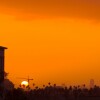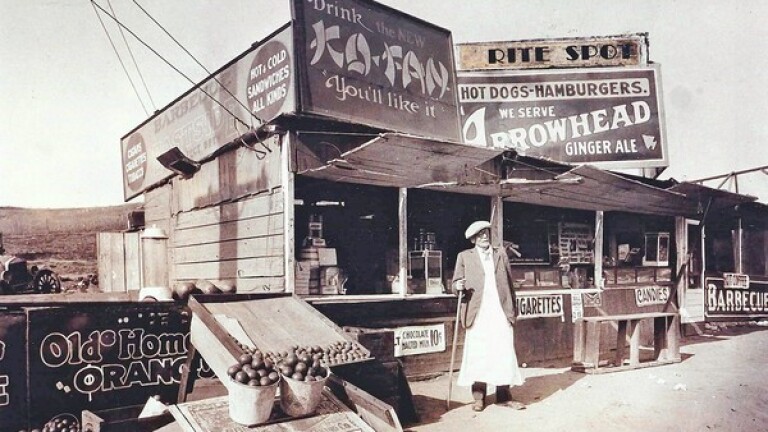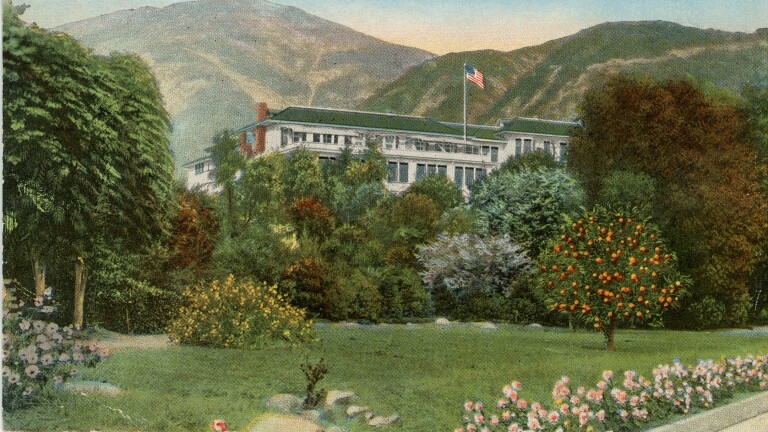A Brief History of L.A.'s Vintage Street Lights

Electric light first fell on Los Angeles in 1882 from eye-searing arc lamps at the top of a mast 150 feet tall. By 1885, there were 30 of these "moonlight towers" in the downtown business district and 200 more in the city's suburbs. The pervasive glow all night long became an annoyance that insomniacs, chickens and strolling lovers could do without.
Conventional street lights with incandescent lamps began replacing the towers in 1905. Broadway was first, illuminated by 135 lamp posts (called electroliers) from First Street to Main Street, financed by the Broadway Boulevard Improvement Association. Each electrolier had a cluster of six smaller globes surmounted by a larger one.
Multiple lamps were necessary because none of them was very bright (generally between 40 and 60 watts).
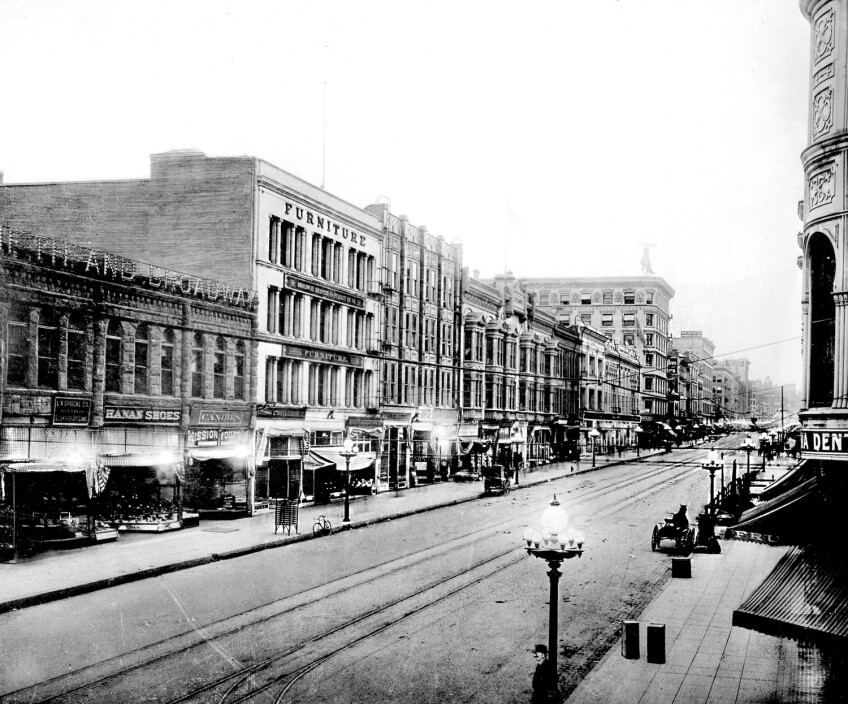
Though dim, these first lights still seemed magical. "Broadway burst into bloom last evening," the Los Angeles Times enthused in 1905. "Like its more illustrious namesake in New York, the Broadway of Los Angeles finally has a great white way. … There was something intoxicating about the mellow glow of the little lamps that mellowed many a heart usually callous."
The electroliers were fabricated by the Llewellyn Iron Works, a Los Angeles foundry that became locally famous for its street lights. The basic configuration was simple: a thick base from which a slender pillar rose to a capital that radiated arms to support the lamps. Other early electroliers had three-globe arrangements (suitable for residential neighborhoods).
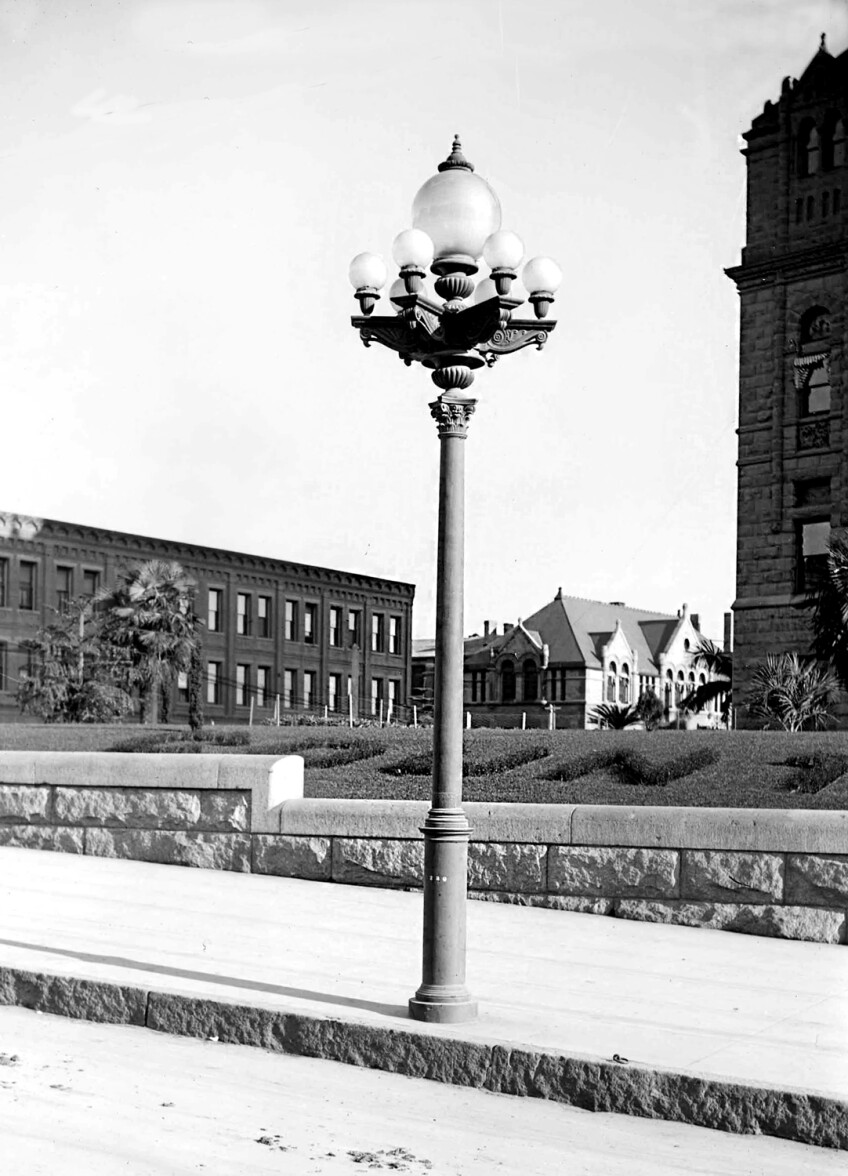
After Broadway was lighted, Hill, Main and Spring streets became "radiant ways" with Llewellyn electroliers. These had five globes rather than Broadway's seven-globe lights, keeping Broadway the brightest Los Angeles street.
Downtown's street lights were installed by business associations who contracted to purchase the fixtures, lay wiring and provide power. It wasn't until 1916 that the city delivered municipal power to street lights.
Street lighting provided by business associations — aimed at making retail streets inviting to shoppers at night — gave Los Angeles an unusual distinction. As India Mandelkern notes, "[W]ith more than 400 different types of lamps scattered over nearly 470 square miles, L.A. is one of the most diverse street light ecosystems anywhere in the country."
You can find authentic examples of three- and five-globe electroliers on Carroll Avenue in Angelino Heights, appropriately among the Heights' Victorian houses.
Street Lights and Social Hierarchy

Decorative pillar and lamp combinations began replacing multi-globe street lights after 1915. They were city-approved designs paid for by surrounding property owners who had voted to form a lighting assessment district. The first of these was in Van Nuys.
Ornamental electroliers produced by Llewellyn, the Keystone Iron and Steel Works and Union Metal Company of Ohio, were a selling point for the San Fernando Valley's new subdivisions, which led to neighborhood-specific street lights becoming a design feature of Los Angeles.
Their diversity reflected class distinctions. Wealthy neighborhoods had dual-lamp electroliers with design details from imperial Rome or medieval England. Middle-class subdivisions might have the standard pillar with a single, acorn-shaped globe. Working-class streets had utilitarian lights hung from telephone poles.

The grandest Los Angeles street lights are the Specials installed in the 1920s and 1930s along the city's expanding street grid. Wilshire Specials once lined the boulevard from Park View Street to Fairfax Avenue, their bronze lanterns bracketed at the corners by partially nude figures. The Specials on Olympic Boulevard had curvy mythological creatures supporting one- and two-lamp configurations. The Melrose Hill Special draped the elliptical curves of an Art Nouveau frame around a vase-like cone.
The Broadway Special by Keystone Iron and Steel (which the Los Angeles Times called "one of the most elaborate jobs of ornamental electroliers ever made on the coast") was a stately, two-lamp electrolier draped with garlands of roses.

Where can Specials be found today? Wilshire Specials can be found along Wilshire Boulevard west of Union Avenue. Melrose Hill Specials can be found on Marathon Street at Hobart Boulevard.
The Specials on Olympic Boulevard west of Crenshaw Boulevard retain their unusual support structure but their pendant lamps have been replaced with horizontal LED assemblies. Broadway Specials are gone, but the similar, slightly less ornate Broadway Rose electroliers have been transplanted to 6th Street between Olive and Flower streets.
Benedict Canyon Drive northwest of DeCamp Drive retains a few Bishop's Crook Specials manufactured by Union Metal. They have a pendent, tear-drop lamp. Westwood Village was once illuminated by lanterns rising from a base tiled in UCLA blue and gold. Reproductions of these Specials are used as sidewalk lighting on Westwood Boulevard at Kinross Avenue.
A bit of motorized flânerie will reveal more Specials along the city's major streets or tucked into older suburbs. They're still glowing brightly after nearly a hundred years, thanks to the men and women of the city's Bureau of Street Lighting.
But not all of Los Angeles is fully lit even now. In some neighborhoods of Van Nuys, Reseda and North Hollywood, nighttime streets are illuminated by the moon, the stars and the city's glow reflected from an occasional cloud.
Art of the Street Light
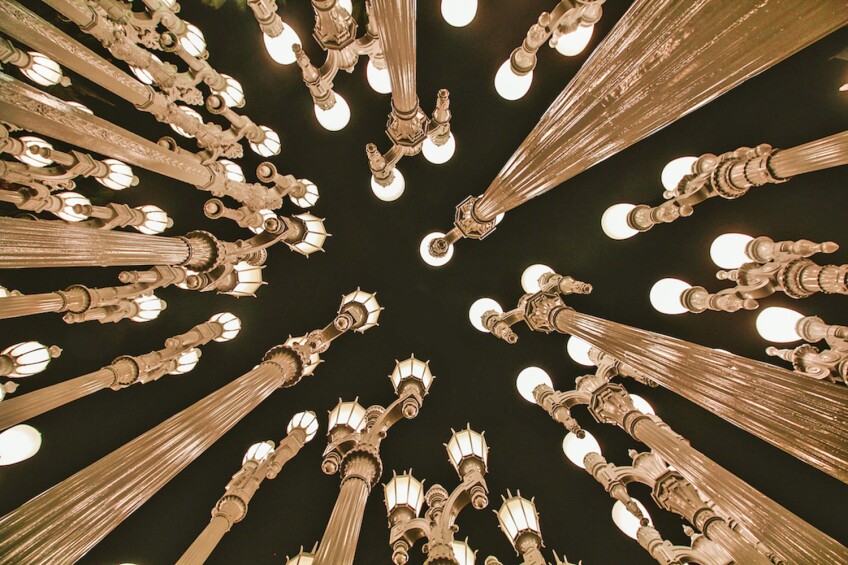
Two outdoor displays show the quirky artistry of the city's street lights.
Chris Burden's "Urban Light" is a temple-like cluster of 202 vintage street lights at the entry to the Los Angeles County Museum of Art on Wilshire Boulevard. By day, it's a forest of fluted pillars. When lit, the electroliers cast a dense — almost fierce — brightness. "Urban Light" has become an icon of Los Angeles. It's more Instagrammed than the Hollywood Sign.
Impressive in its own way is Sheila Klein's "Vermonica," a display of 25 electroliers that charts the city's street light history. Formerly in the parking lot of a strip mall at the intersection of Vermont Avenue and Santa Monica Boulevard, "Vermonica" is now at 4582 Santa Monica Blvd. and adjacent to the offices of the Bureau of Street Lighting. The collection includes rare examples of designs that have been lost to modernization.

Klein's original intent remains intact at the artwork's new location: to instill a habit of paying attention to the gifts that Los Angeles makes to its streets. As Klein notes on her website, "'Vermonica' seeks to uncover romantic truths about the city. By accenting one overlooked layer of our environment, ['Vermonica'] encourages further consideration of all our urban layers."
You might say that by looking around, Angelenos will see their city in a different light.
Explore
Photographs and location information to help you explore the diversity of the city's street lighting are in the Los Angeles Citywide Historic Context Statement, Street Lights and the Bureau of Street Lighting, 1900-1980 (City of Los Angeles Department of City Planning, Office of Historic Resources, June 2017).
The Bureau of Street Lighting maintains a street light museum that features displays of early lamps. Visit via an online tour.
Sources
Water and Power Associates (blog). Early Los Angeles Street Lights
Comer, Virginia. Streetlights. Los Angeles: Balcony Press, 2000.
Feldman, Eddy S. The Art of Street Lighting in Los Angeles. Los Angeles: Dawson's Book Shop, 1972.
Gelt, Jessica. "The five-globe Llewellyn? A photo history of L.A. streetlight design since 1882," Los Angeles Times, 09/05/2020.



